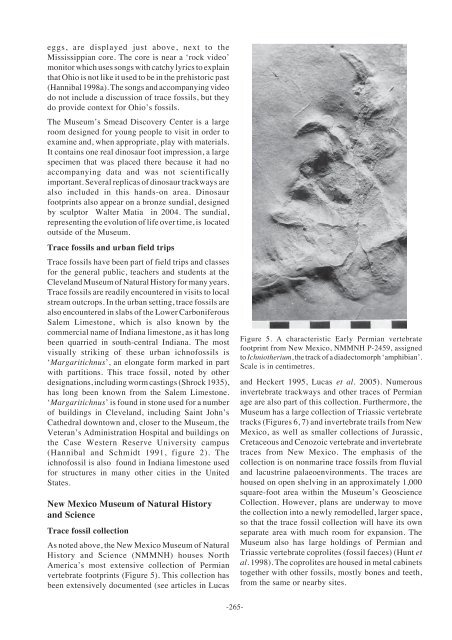Continental trace fossils and museum exhibits - Geological Curators ...
Continental trace fossils and museum exhibits - Geological Curators ...
Continental trace fossils and museum exhibits - Geological Curators ...
You also want an ePaper? Increase the reach of your titles
YUMPU automatically turns print PDFs into web optimized ePapers that Google loves.
eggs, are displayed just above, next to theMississippian core. The core is near a ‘rock video’monitor which uses songs with catchy lyrics to explainthat Ohio is not like it used to be in the prehistoric past(Hannibal 1998a). The songs <strong>and</strong> accompanying videodo not include a discussion of <strong>trace</strong> <strong>fossils</strong>, but theydo provide context for Ohio’s <strong>fossils</strong>.The Museum’s Smead Discovery Center is a largeroom designed for young people to visit in order toexamine <strong>and</strong>, when appropriate, play with materials.It contains one real dinosaur foot impression, a largespecimen that was placed there because it had noaccompanying data <strong>and</strong> was not scientificallyimportant. Several replicas of dinosaur trackways arealso included in this h<strong>and</strong>s-on area. Dinosaurfootprints also appear on a bronze sundial, designedby sculptor Walter Matia in 2004. The sundial,representing the evolution of life over time, is locatedoutside of the Museum.Trace <strong>fossils</strong> <strong>and</strong> urban field tripsTrace <strong>fossils</strong> have been part of field trips <strong>and</strong> classesfor the general public, teachers <strong>and</strong> students at theClevel<strong>and</strong> Museum of Natural History for many years.Trace <strong>fossils</strong> are readily encountered in visits to localstream outcrops. In the urban setting, <strong>trace</strong> <strong>fossils</strong> arealso encountered in slabs of the Lower CarboniferousSalem Limestone, which is also known by thecommercial name of Indiana limestone, as it has longbeen quarried in south-central Indiana. The mostvisually striking of these urban ichno<strong>fossils</strong> is‘Margaritichnus’, an elongate form marked in partwith partitions. This <strong>trace</strong> fossil, noted by otherdesignations, including worm castings (Shrock 1935),has long been known from the Salem Limestone.‘Margaritichnus’ is found in stone used for a numberof buildings in Clevel<strong>and</strong>, including Saint John’sCathedral downtown <strong>and</strong>, closer to the Museum, theVeteran’s Administration Hospital <strong>and</strong> buildings onthe Case Western Reserve University campus(Hannibal <strong>and</strong> Schmidt 1991, figure 2). Theichnofossil is also found in Indiana limestone usedfor structures in many other cities in the UnitedStates.New Mexico Museum of Natural History<strong>and</strong> ScienceTrace fossil collectionAs noted above, the New Mexico Museum of NaturalHistory <strong>and</strong> Science (NMMNH) houses NorthAmerica’s most extensive collection of Permianvertebrate footprints (Figure 5). This collection hasbeen extensively documented (see articles in LucasFigure 5. A characteristic Early Permian vertebratefootprint from New Mexico, NMMNH P-2459, assignedto Ichniotherium, the track of a diadectomorph ‘amphibian’.Scale is in centimetres.<strong>and</strong> Heckert 1995, Lucas et al. 2005). Numerousinvertebrate trackways <strong>and</strong> other <strong>trace</strong>s of Permianage are also part of this collection. Furthermore, theMuseum has a large collection of Triassic vertebratetracks (Figures 6, 7) <strong>and</strong> invertebrate trails from NewMexico, as well as smaller collections of Jurassic,Cretaceous <strong>and</strong> Cenozoic vertebrate <strong>and</strong> invertebrate<strong>trace</strong>s from New Mexico. The emphasis of thecollection is on nonmarine <strong>trace</strong> <strong>fossils</strong> from fluvial<strong>and</strong> lacustrine palaeoenvironments. The <strong>trace</strong>s arehoused on open shelving in an approximately 1,000square-foot area within the Museum’s GeoscienceCollection. However, plans are underway to movethe collection into a newly remodelled, larger space,so that the <strong>trace</strong> fossil collection will have its ownseparate area with much room for expansion. TheMuseum also has large holdings of Permian <strong>and</strong>Triassic vertebrate coprolites (fossil faeces) (Hunt etal. 1998). The coprolites are housed in metal cabinetstogether with other <strong>fossils</strong>, mostly bones <strong>and</strong> teeth,from the same or nearby sites.-265-
















